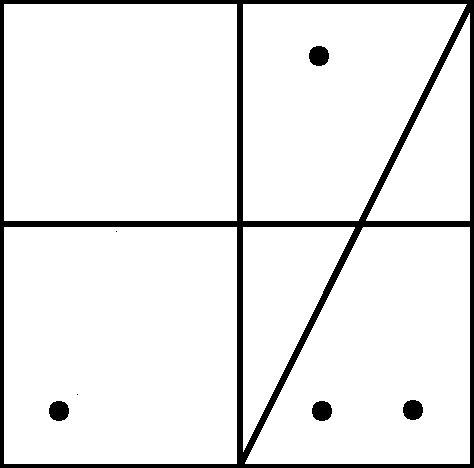
| Cookie |
The Association of Cookie Makers (ACM) has developed its newest and most decadent cookie in history, the ``Square Chocolate Chip Cookie''. This new cookie is a biscuit delight with lots and lots of chocolate chips for all the cookie lovers out there. However, in the development of this revolutionary type of cookie, the chocolate chips sprinklers have had some problems; though all the chips fall on the cookie, they are not evenly spread.
With a tradition of more than 26 years of cookie making, ACM sprinklers cannot be
replaced. That is why the sales department has decided to cut the cookie in several pieces to
maximize revenue. Each cut is made by a laser that moves across the cookie following a straight line
path. Any chip chocolate on the laser path is destroyed during the cut process. Each piece of a
square cookie is then valued according to its chocolate chip density, defined as the number
of chips that it has, divided by its area.
The following figure shows an original cookie with four chips and three cuts. It is
apparent that the piece at the lower right corner has a maximal chocolate chip density.

As part of the product testing team at ACM, you have to write a program that detects the maximal chocolate chip density among the resulting pieces, given an original square chocolate cookie, the positions on it that received a chocolate chip, and the cuts that should be made.
The input consists of several test cases. The first line in a test case contains three
integers L, C, and K, separated by blanks, where L is the length of the cookie side, C is
the number of chips, and K is the number of cuts (
2 ![]() L
L ![]() 500,
0
500,
0 ![]() C
C ![]() 5000,
0
5000,
0 ![]() K
K ![]() 50). Each one of the following C lines contains two
blank-separated integers
50). Each one of the following C lines contains two
blank-separated integers ![]() and
and ![]() , representing the (x, y) coordinates of a
chocolate chip (
0 <
, representing the (x, y) coordinates of a
chocolate chip (
0 < ![]() < L,
0 <
< L,
0 < ![]() < L) in a Cartesian coordinate system where
the cookie is represented by the square with vertices (0, 0), (L, 0), (L, L), and (0, L). Each
one of the following K lines contains four blank-separated integers x1, y1, x2, and
y2, representing two distinct points on a straight line that defines a cut on the same coordinate
system (
0
< L) in a Cartesian coordinate system where
the cookie is represented by the square with vertices (0, 0), (L, 0), (L, L), and (0, L). Each
one of the following K lines contains four blank-separated integers x1, y1, x2, and
y2, representing two distinct points on a straight line that defines a cut on the same coordinate
system (
0 ![]() x1, y1, x2, y2
x1, y1, x2, y2 ![]() L). You may suppose that there are not two chocolate chips
placed at the same location. The last test case is followed by a line containing three zeros.
L). You may suppose that there are not two chocolate chips
placed at the same location. The last test case is followed by a line containing three zeros.
For each case, output a single line with a number indicating the maximal chocolate chip density among all the resulting pieces after the cuts. You may suppose that no answer will be greater than 102. The answer should be formatted and approximated to three decimal places. The floating point delimiter must be `.' (i.e., the dot). The rounding applies towards the nearest neighbor unless both neighbors are equidistant, in which case the result is rounded up (e.g., 78.3712 is rounded to 78.371; 78.5766 is rounded to 78.577; 78.3745 is rounded to 78.375, etc.).
6 4 3 1 1 4 1 5 1 4 5 3 0 3 6 0 3 6 3 3 0 6 6 0 0 0
0.296